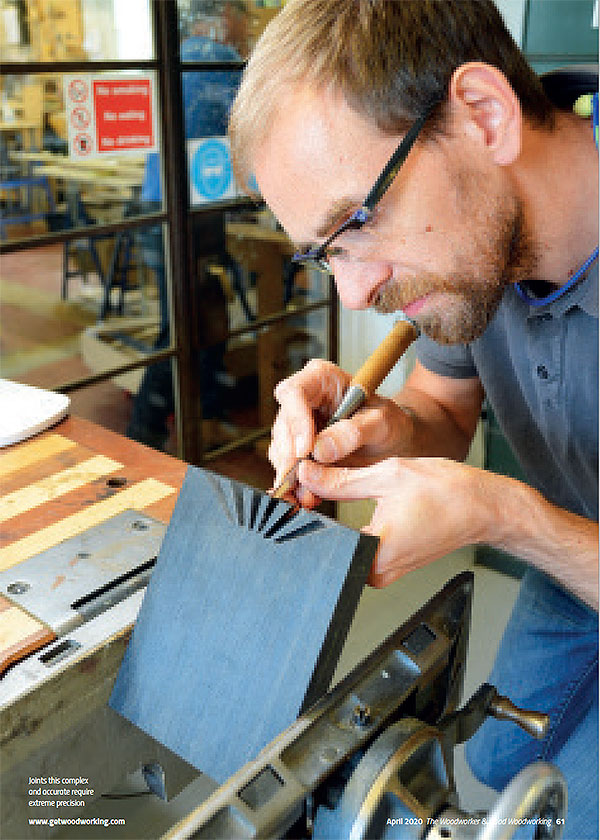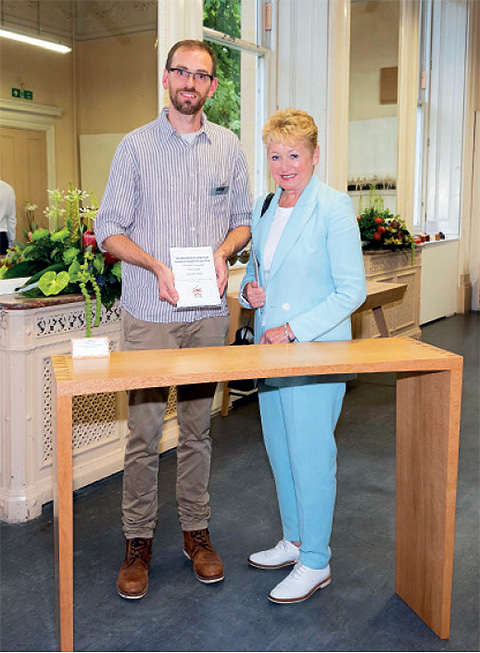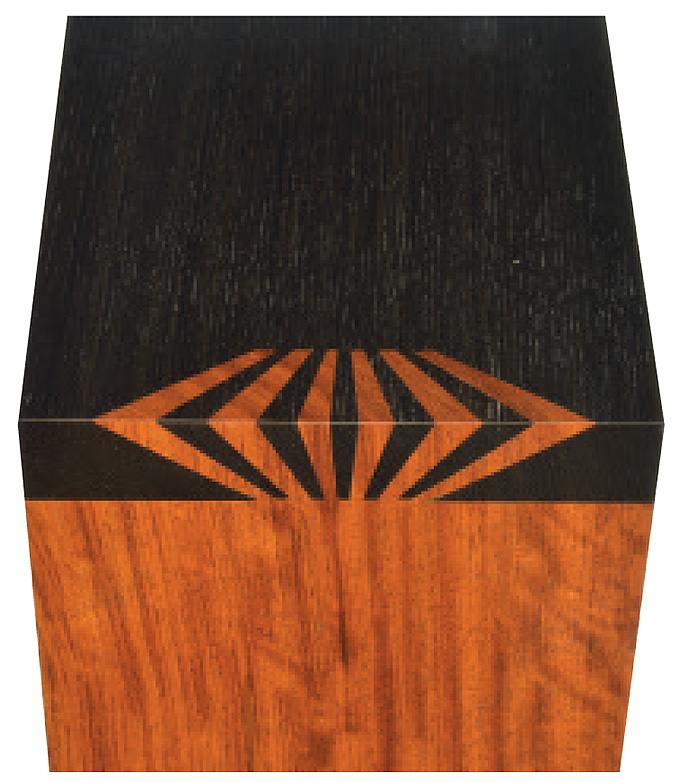We were delighted to have our senior tutor featured in The Woodworker & Good Woodworking magazine.
When Art Meets Engineering
Undoubtedly a singularly gifted and knowledgeable individual, it is reassuring to know that someone like Theo Cook is instructing and inspiring the next generation of furniture makers in their craft, as Martin Pim-Keirle discovers here.

The human brain is the single most complex thing we know of, and the way it can be adapted to all manner of purpose is truly awe-inspiring. There is something particularly wonderful about those gifted individuals who excel in both art and science simultaneously, and history is replete with examples of the polymath artist-engineer. From Leonardo Davinci to Hedy Lamarr, there have always been a lucky few with abilities that span both spheres.
Fortunately for us, our shared passion is an area in which this duality is more common than most. In a Venn Diagram of engineers and artists, there would surely be more woodworkers at the intersection than any other single profession. It’s a craft that demands an understanding of materials science, engineering and mathematics, and yet truly great work is only possible when these academic skills are combined with a strong aesthetic sensibility and a fundamental urge for creative self-expression.

Theo Cook is clearly one such individual, a status confirmed when he recently received two awards on the same day: one in recognition of his furniture-making skills, and the other for a set of exquisitely-crafted hand planes. His work perfectly exemplifies that balance between artistic expression and engineering nous, with an almost improbable level of manual skill thrown in for good measure.
As he says himself: “You have to have an understanding of the materials you’re working with in order to be creative with them.”
Barnsley apprenticeship & beyond

The softly-spoken tutor of a small furniture school in East Sussex, Theo’s manner is somehow that of one who has spent time in academia, yet in reality he left school at 16, dyslexia making academic success more challenging than it might otherwise have been, and embraced his natural affinity for practical subjects. A two-year City & Guilds at Highbury College in Portsmouth followed, and with the encouragement of one particular tutor, Theo was able to secure a place on the shortlist for a five-year apprenticeship at the Barnsley Workshop. Famously hard to get into, and only taking on one apprentice a year, the Barnsley Workshop is supported by a charitable trust, and is rightly famous for the quality of both its furniture and its craftspeople.
“I think they’re the only place in the country that still offers traditional apprenticeships. When I started, the rule was that you were only allowed to use hand tools for the whole of the first year – I wasn’t even allowed to use a jigsaw to cut up timber!” recalls Theo.


He initially began by making stock pieces, then, once he was judged to have built up sufficient skill, he was able to move on to commissions and speculative pieces: “At Barnsley, we were always taught to work to the highest standards, and that’s stayed with me. I may work slower than some, but I pride myself on making very few mistakes.”
It was during his apprenticeship that Theo had the opportunity to study at the College of the Redwoods for nine months:
“It was the first time I’d left home, so it was a liberating experience. It was also the first time I’d had the freedom to design and make my own pieces. James Krenov, the iconic furniture maker who founded the school, was 80 at the time, but he still made time to come and chat to the students. He’s a really inspirational character – he was our Yoda!”

At the end of his apprenticeship, Theo stayed on at Barnsley for two years as a craftsman before going to work for Senior & Carmichael for a further nine years. Now Vice Principle and a Partner at Robinson House Studio, Theo only began teaching in 2014, after an enquiry about using their bench space led to an arrangement with Robinson House to teach a few hours a week in return for use of the workshop.
An extreme eye for detail
These days Theo spends most of his time teaching, and as for life outside of the workshop, he says he’s always happy “doing something practical – I enjoy car maintenance and I’ve tinkered with my cars quite a lot in the past. These days, though, if I’m not teaching or making furniture, I’m usually changing the baby’s nappies or running around softplay with my five-year-old!”
Despite the relatively late start, passing on knowledge clearly comes naturally to Theo, something that is obvious from his YouTube videos. On the subject of what makes a good student, Theo says:
“The most important characteristics for a student are passion and dedication. There’s so much to learn. You also need to be well-organised and a hard-worker.”
Based on the content of his videos he might also like to add ‘must have an extreme eye for detail’ to that list. Where most of us are content working the nearest millimetre, or even half-millimetre if we’re feeling brave and have our reading-glasses handy, Theo is operating at another level of accuracy entirely. There is a particularly memorable moment during his instructional video on Japanese dovetails where, in absolute seriousness, Theo instructs the viewer that it is important to reduce a particular measurement by 0.1mm before marking out in order to achieve the best possible end result. This, then, is a woodworker who truly understands what it means to work with precision.
And nowhere is that clearer than in the work you see before you. Theo’s beautiful console table in Japanese oak was Highly Commended at The Furniture Makers’ Company Design Award, while on the same day his hand planes were crowned winner in The Future Icons Award for Accessories. Not bad considering that this was the first time Theo had exhibited under his own name, rather than representing an employer.
The console table’s graceful and apparently simple form hides an array of finely-crafted details that undoubtedly elevate the whole piece. The legs are tapered in both directions, giving the table subtle poise and grace, while the lower edge along the front is chamfered, slimming the appearance considerably, retaining strength while adding elegance. And this is before we consider the standout detail of the piece: beautiful Japanese dovetails that join the sides to the top, a feature that is a stunning visual device for the uninitiated, and a supreme expression of the maker’s skill and accuracy for those in the know.
Zero margin for error
Once you understand just how much skill and experience goes into creating these beautiful joints, it is impossible not to feel somewhat in awe of the maker. Talking about the build process for the table, Theo says: “It took about six weeks, working evenings and weekends around my teaching. The Japanese dovetails took the longest, as they’re incredibly hard to make, with zero margin for error.” Perhaps unsurprisingly, Theo’s console table sold almost immediately – a bittersweet moment for its maker: “Obviously I was really pleased when it sold, but you’re always a bit sorry to see something go that you’ve worked really hard on. I’d only finished the table the week before, so I hadn’t really had it around to appreciate much.”

And on the subject of how he is able to work with such precision, he says: “It does take a lot of experience to work to this level of accuracy, but it’s the only way to achieve a Japanese dovetail that’s going to fit together. I used Japanese oak – you need wood with a fine grain, and it needs to be quartersawn and well-seasoned.”
If you are unfamiliar with Japanese dovetails it is probably worth taking a moment to look closely at the photos. The thing that strikes you first (aside from the almost impossibly perfect fit) is the complexity of the joints. You might also have the passing thought that they seem as if they could not possibly fit together, the dovetails apparently working to resist pull-out in both lateral and longitudinal directions at the same time. Only when you discover that the two pieces fit together by sliding at 45° to each face does the joint begin to make sense. And when I tell you that Theo’s toolkit for cutting these joints includes digital callipers, a scalpel and a selection of homemade chisels slim enough to fit the restricted space, you may begin to see how that incredible level of precision might be possible.
Planes in the Krenov style
Precision is also a key ingredient in Theo’s beautiful hand planes. His submission for the award consisted of five planes, all in the Krenov style and all featuring Hock blades: “I like Hock blades – I started using them as the company was local to the College of the Redwoods, but I still use them now.” Theo favours the A2 steel used in these blades as he feels it takes a better edge and retains it for longer than some alternatives.
A variety of woods were used for the planes, from ziricote to pink ivory, all beautiful in their own ways, and crucially all stable and close-grained. All have a separate sole made from either rosewood or lignum vitae. Theo favours a bed angle of 45° for smoothing planes and 30º (in the other direction) for scrapers.

It was during his time at the College of the Redwoods that Theo made his first wooden plane, a simple jack plane, also in the Krenov style, maple-bodied with a cocobolo sole. It is fair to say he fell in love with both the process and the end result, and has been making planes regularly ever since. For Theo, one of the great pleasures of making his own tools is the control it affords him; being able to choose the wood and shape the tool to suit his own way of working: “It’s got to be comfortable in your hand and not too heavy.”
Although it seems fair to describe Theo’s planes as being influenced by Krenov in their form and construction, there is certainly a difference in the quality of finish. As Theo himself says of Krenov:
“His planes were more about just making a practical tool. He felt that if the plane was usable straight off the bandsaw, then that was fine.”
Theo’s planes, on the other hand, while also being functional tools of the highest quality, are each minor works of art in their own right, organic sculptural forms in exotic hardwoods that would not look out of place on display in an art gallery.
The judges of the award noted that plane making is listed as a critically endangered skill set on the Heritage Crafts ‘red list’. Does this surprise Theo? “It does surprise me as they’re really satisfying to make, and it’s something practical that you can use. I regularly use the planes I make – particularly the scraper planes.”
Louisa Pacifico, from Future Icons, commented that they were: “A cohesive collection of beautifully made planes, with a very fair price point. Instant collector items. I’m delighted to see a maker investing time to create such beautiful tools that can be handed down to generations to come.”
Proudest achievements
So is it the console table or the planes that are his proudest woodworking achievement so far? Neither, as it turns out: “I made two desks for the Duchess of Northumberland, which I think are the best pieces of furniture I’ve made to date. One is on display at Alnwick Castle – you can see a picture on the Robinson House Studio website. [here]”

Whether making it himself or teaching others the skills they need, it seems it is with furniture that Theo’s heart will always lie. Making tools can bring great satisfaction, but the broader challenge of furniture still contains much uncharted territory, and therefore more for this artist, engineer and teacher to get his teeth into. Undoubtedly a singularly gifted and knowledgeable individual, it is reassuring to know that someone like Theo is instructing and inspiring the next generation of furniture makers.
April 2020 – The Woodworker & Good Woodworking



